Sand Impaction in Dogs - How Dangerous It Is?
25.12.2021.
We can agree that humans like to go to a beach and enjoy the sun, sea, and other fun activities, and when you add your best friend into this mix, things should get even better. Most dogs will love spending time on the beach, swimming, and playing in the sand. This is where the dangers can arise. Have you ever heard about sand impaction in dogs? If you haven't, this is what you should know.
What is sand impaction in dogs?
Sand impaction in dogs can be described as total blockage of the dog’s intestinal tract. While sand is lovely on the beach, it is not that nice when it’s lodged in your dog’s intestinal tract. When the sand is dry, it is light, and you can easily brush it off. However, when the sand gets wet, it can easily form a solid lump.
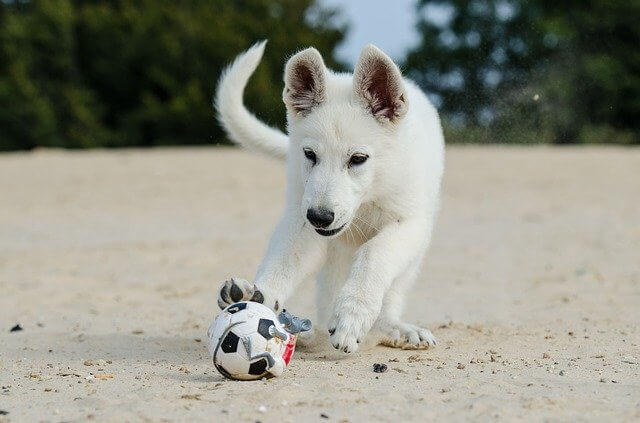
RELATED: How To Prepare For A Dog Beach Day
How does sand impaction happen?
Sand impaction happens when a dog ingests too much sand. Generally speaking, a tiny bit of sand in your dog’s intestinal tract won’t cause too much of a problem. However, when there is a lot of it, it will form a lump that can completely block your dog’s digestion. The biggest problem with it is that dog owners aren’t aware of this potential problem. They will play with their dog on the beach and only notice something wrong when the dog starts exhibiting issues. Here are a few possible scenarios of how sand impaction can happen;
Playing
We take our dogs to the beach to allow them to run and play freely on a soft surface. Dogs love running and playing in the sand, and owners love providing that to their dogs. Throwing your dog’s toys, like a tennis ball, will pick up sand. Your dog will grab it and accidentally ingest some sand. If that happens for quite some time, the amount of ingested sand can be significant.
Digging
If you visit the beach during hot summer days, your dog might look for somewhere to cool down. The easiest way to do that is to dig into the sand. The lower parts weren’t exposed to direct sunlight, which means they are significantly cooler. When dogs dig, the sand enters their mouths, and dogs ingest it.
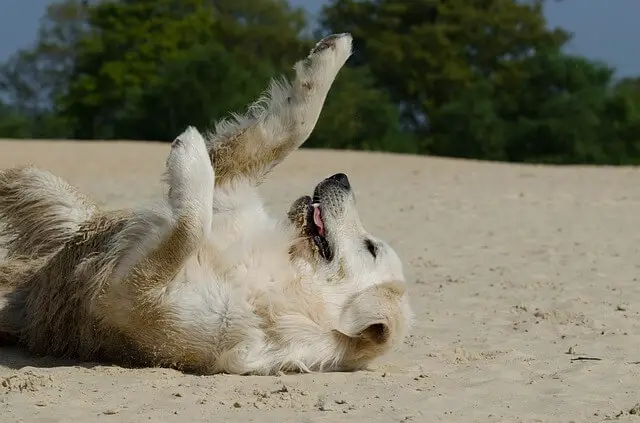
Eating sand
Some dogs find sand so appealing they start to eat it. It is not the only inedible thing dogs might try to eat. They also eat poop or dirt. There is even a condition called “pica” that causes dogs to eat inedible things. If the dog gobbles down too much sand, sand impaction can happen.
Drinking water
If your dog starts gulping muddy water, they might gulp down quite a bit of sand. You must ensure your dog’s water bowl is always clean and sand-free. The same goes for dogs that are playing in the water. You have to prevent them from drinking muddy water.
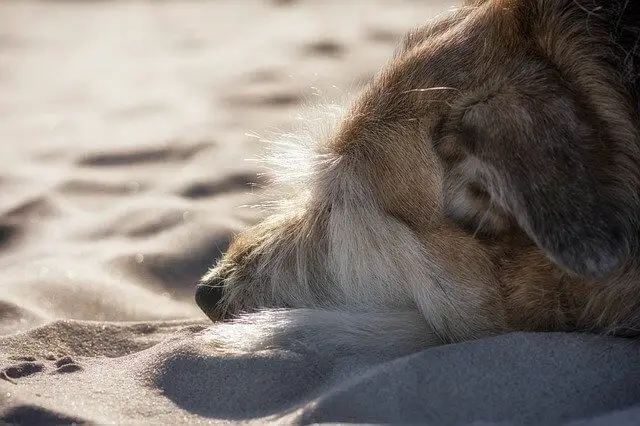
How can I know my dog has sand impaction?
The best way to know your dog has sand impaction is to look back at the time you spent with your dog on the beach. Try to remember if your dog drank sandy water or if they dug up a hole. Did you play fetch for a long time? All of those things can help your vet determine what’s actually wrong with your dog. Even if you can’t remember whether your dog has done any of those things, you should still tell your vet you took your dog to the beach.
RELATED: How Long Can a Dog Stay on the Beach
Symptoms of sand impaction in dogs
Most dog owners notice their dogs are exhibiting specific symptoms and problems after their beach visit. If you think something’s wrong with your dog and you’re worried about their health, you should learn what sand impaction symptoms are. Try to match them with your dog. However, call your vet as soon as you notice something’s wrong with your dog; don’t surf the internet for questionable answers. Here are some of the most common sand impaction symptoms in dogs;
- Severe constipation
- Abdominal pain
- Vomiting
- Dehydration
- Panting
- Restlessness
- Solid mass in the stomach area (very hard under your fingertips)
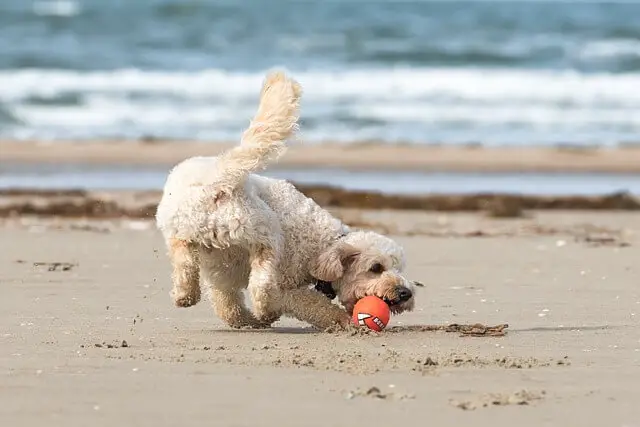
How is sand impaction in dogs treated?
The first step to successful treatment is an accurate diagnosis. Your vet will thoroughly examine your dog. They will palpate their abdomen, analyze symptoms, and ask for X-rays. That is usually more than enough to diagnose sand impaction in dogs accurately.
The treatment will have to be determined by the severity of impaction. If your dog gobbled down insane amounts of sand, your vet might demand surgery. That might be the only way to clear all the sand out of your dog’s digestion. The vet will most likely prescribe IV fluids, dog laxatives, and pain medications in milder forms of sand impaction. This type of treatment will help your dog pass the lodged sand. You should know that both forms of treatment might require hospitalization.

Can I prevent sand impaction?
The first obvious way to prevent sand impaction in dogs is to keep a close eye on your dog. Make sure your dog doesn’t eat sand on the beach. If that happens, you have to stop them. It would be pretty good if your dog knew the “No!” or “Leave it!” command. That way, you can allow your dog to run freely and only yell commands when they start doing something they shouldn’t.
The second thing you can do is take toys that will repel sand. Instead of a tennis ball, take a smooth plastic ball. Instead of a plush toy, take a plastic frisbee. These types of toys will not pick up as much sand as the other ones, and your dog should be able to pick it up without eating too much sand.
Make sure your dog has a place where they can safely cool off. Bring a sunshade and plenty of fresh water your dog can drink. It would be ideal if you could bring enough fresh water to wash your dog. That way, you will remove sand, salt, and debris your dog picked up on the beach. If you can’t bring so much water, you should make sure you wash your dog as soon as you come home.
Other risks for your dog at the beach
Taking your dog to the beach can be a fun and rewarding experience for the dog, but you must understand all the potential risks connected to beaches to protect your dog. In addition to sand ingestion, these are some other potential risks dogs could experience on the beach.
1. Saltwater ingestion
Drinking too much of salt water will lead to dehydration, vomiting, diarrhea, and electrolyte imbalance. Dehydration is a serious health concern, so you need to make sure that you always have enough clean and fresh water with you.
2. Heatstroke
During hot summer days, dogs could quickly overheat. You should always provide shade and fresh water to your dog to prevent heatstroke. Also, you should avoid going to the beach during the hottest parts of the day.
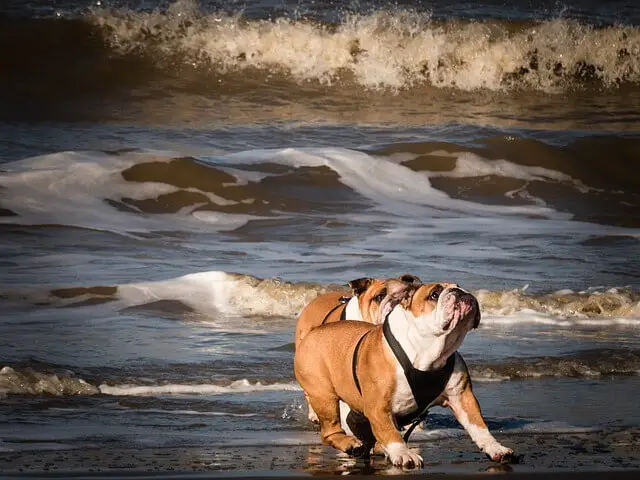
3. Sunburn
Certain dogs, especially hairless ones with thin coats, are in danger of sunburn. You can use pet-safe sunscreen to protect your dog's skin. If you don't know where to start, this article can help you decide - Do Dogs Need Sunscreen?
4. Drowning
Not all dogs are natural swimmers, but even the strongest swimmers can potentially drow if the current is strong. When your dog is in the water, you should always be close and keep an eye on your dog. You should never allow your dog to go far away because this is where the dangers can arise. If your dog is not a very good swimmer, check this article and learn how you can teach him to be a better swimmer - How to Teach a Dog to Swim?
5. Sharp objects
In the sand, we can find different objects, such as broken shells, rocks, or even debris, and all of them could potentially be harmful to our dogs, especially if your dog manages to ingest some. You should always inspect the beach area where your dog will play to ensure nothing bad happens to him.
6. Off-leash dogs
On the beach, dog owners usually don't hold their dogs on the leash, so you must be extra careful when other dogs are around. You should always be aware of your surroundings and follow the local leash laws.
World Dog Finder team







Share